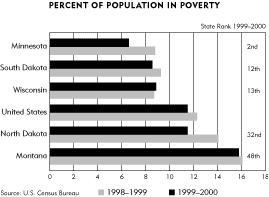Overall, district state poverty rates decreased during 1999-2000. The poverty rate for the nation decreased 0.8 percent from the two-year average of 1998-1999 to 11.5 percent in 1999-2000. Minnesota finished with the second-lowest average poverty rate in the nation at 6.6 percent, 2.2 percent lower than in 1998-99. North Dakota posted the largest decrease in the district, dropping 2.6 percent from the previous two-year average, while Wisconsin was the only state that showed an increase—up 0.2 percent. Montana had the highest poverty rate in the district and ranked 48th in the nation.
Poverty level is calculated by measuring income before taxes, not including capital gains and noncash benefits (public housing, Medicaid, food stamps). The Census Bureau estimates poverty by using a set of income thresholds that vary depending on family size and composition. A family is considered to be living in poverty if its income falls below a designated threshold. In 2000 the poverty threshold for a single adult was $8,959, while the threshold for a family of four with two adults and two children was $17,463.






